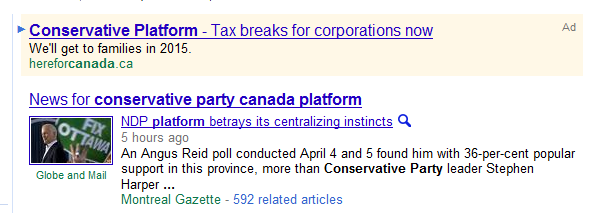Update: Subversive search advertising
The Liberals strike again with some subversive Google advertising when searching for “Conservative party Canada platform”. Something seems off about this ad copy, and clicking it reveals a more straight-forward attack.
Other than some display ads (Update: And some attack ads!) to help voters get to know Michael Ignatieff, online advertising has been vastly overlooked by Canadian political parties during this election campaign.
Canadians are increasingly going online for political information, and federal political parties are missing out on a fantastic opportunity to inform voters at the point of inquiry – and maybe steal some votes away from their competitors.
However behind the times they are as a group, it looks like the Liberals are at the front of the pack. Not only do they employ display ads to help Canadians get to know their leader (and bring associated visits to a customized landing page with video), they’re also getting competitive and are reaching out to those who are searching for information about the Conservatives*.
For instance, if one Googles “Conservative Party Canada platform”, the Conservatives rightly dominate the organic search rankings, but the Liberals show up in the paid search box on the right. This is an interesting strategy from the Liberal Party – hoping to present their side of the story when a Canadian is looking for information about their opponent.
Despite a much smaller party budget, the Online Party of Canada is competing with both the Liberals and Conservatives by buying specific AdWords and directing visitors to their website.
Developing a strategy
If I were a campaign strategist for any party, I would definitely look into buying both my own keywords as well as those of my competitors.
As an advertising vehicle, Google AdWords is ideal for political parties because they can be targeted to particular terms or regions and they’re inexpensive because you only pay per click – not per impression.
Other terms to consider – insert the party, candidate, riding or leader name before the term:
+platform
+health platform
+education platform
+social platform
+fighter jets
+G8
+contempt
It looks like the NDP are using this sort of targeted advertising to focus on people interested in public broadcasting and corruption. Here’s the ad that showed up at the bottom of a recent Gmail thread:
At the local level…
In my local riding, Liberal Scott Bradley is challenging NDP incumbent Paul Dewar. Dewar is by far the more popular search term (due in part to his high-profile assignment as NDP foreign affairs critic) with 1.3-million related pages and 1,300 local searches per month. Bradley is still growing his personal brand with 50-100 monthly local searches and 174,000 related pages.
The upstart Bradley especially has the opportunity to tap into those looking for information on his high-profile adversary and perhaps convert them with some targeted ad copy and a landing page that shows why he and his party is the better choice for undecided voters in his riding.
By the same token, Dewar can intercept voters who are looking for reasons to support Bradley.
There’s no doubt that hand-shaking and baby-kissing are an important part of campaigning for anyone who hopes to get elected. But for any federal party, a little bit of online strategy could have a large, cumulative, and low-cost effect on the results of the election in May.
*Search results are based on a number of factors including browser history and location, you may not have the same results, even if you Google the same terms.


















